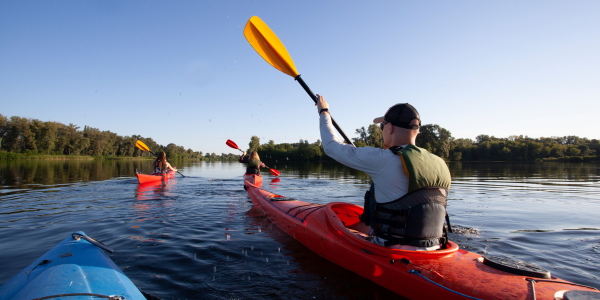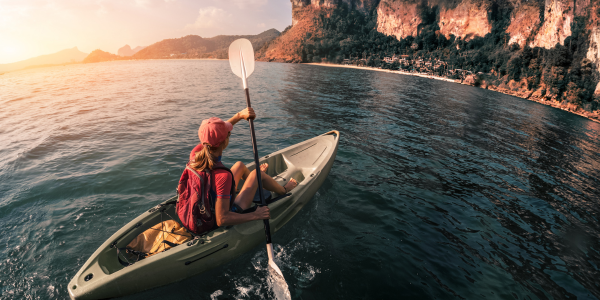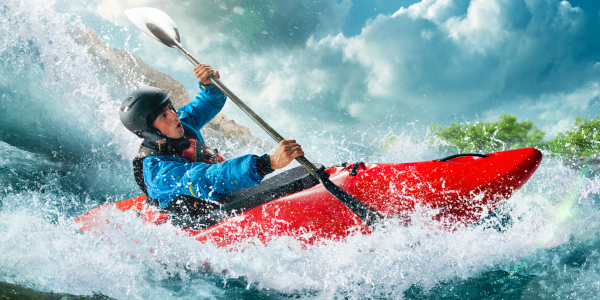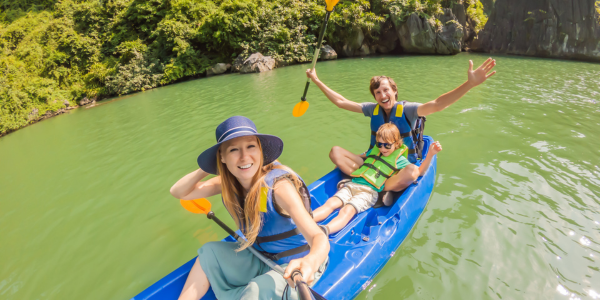Deciding which type of kayak to purchase can be a hard choice is hard enough but is harder if you’re a beginner. This guide was created with the beginner in mind so let’s discuss sit in vs sit on kayaks in great length. We’ve also include images so you can understand some of the key differences a lot better.
There are two basic types of kayaks: one being a sit-in and the other a sit-on. Understanding the differences between the two is crucial for making an informed choice about which one is best for your kayaking activities.
We’re going to discuss the key features and pros and cons of both so that you can purchase the right one for your next water adventure.
Pros And Cons Of Sit In Kayaks
Sit-in kayaks are kayaks that you sit inside of instead of on top of. They are a popular choice for those who want safety and comfort when exploring the water. They also offer you more protection from the elements than sit-on-top kayaks.

With sit-in kayaks, you have an easier time controlling your speed and direction. It even feels like more of a natural fit for beginner kayaks compared to the alternative we’re discussing here.
However, there are also some drawbacks to consider when choosing a sit-in kayak.
Pros
- Sit-in kayaks are more stable than the sit-on-top types because the cockpit of a sit-in offers a lower center of gravity. This can be helpful in rough waters or when paddling with gear and supplies as it adds balance to the boat.
- Because of the enclosed cockpits, sit-in kayaks will provide extra protection from the elements such as waves, wind, and cold water.
- Many sit-in kayaks provide plenty of storage compartments for gear and supplies, which allows you to bring more items, especially for a longer trip. Anything that’s stored inside these compartments will remain dry even if the boat takes on some water.
- For those who want more speed and better performance, sit-in models are the better choice because of their sleeker hull shape and reduced drag. This is ideal for long touring trips or races.
- Some touring kayaks come with adjustable feet rests, which would allow for a more relaxed paddling position for maximum efficiency and comfort during those long trips.
Cons
Sit-in kayaks do offer the paddler better protection from the elements than sit-on-top kayaks. However, they also come with drawbacks that you should consider.
- One potential problem with sit-in kayaks is mobility especially for heavier or taller paddlers since they can be harder to get in and out of. A bigger person might feel cramped and uncomfortable due to the limited legroom inside the cockpit.
- If you capsize in a sit-in kayak, you will likely need assistance to get back in. This would be more dangerous if you are far away from shore, alone, without anyone to help you.
- Many anglers prefer using sit-in kayaks because of their higher stability over sit-on-top models. You have to be stable when catching fish or possibly warding off sharks for that matter!
Pros And Cons Of Sit On Kayaks
If you remember, we discussed that sit-on kayaks are kayaks that you literally sit-on-top:

Pros
Sit-on kayaks have seen an increase in popularity due to their versatility, comfort, and affordability. Here are some of the key benefits of sit on kayaks:
- Sit-on-top kayaks are very easy to use and require no expertise or prior instructions. The design of the kayak requires less physical effort than your typical sit-in counterpart. You can easily get back onto the boat if you fall into the water.
- Sit-on-top kayaks feature a wide, flat hull that will provide a stable ride. This is ideal for beginners or those who plan for a leisurely trip down a calm river or lake.
- These types of kayaks can be used in almost any water environment from lakes to rivers to oceans, making them an excellent choice for those who like to have fun on all types of water conditions.
- Sit-ons often come with seats that have padding and adjustable footrests, which will provide superior back support and comfort while paddling.
Cons
- Most sit-on-top kayaks generally have less storage space than sit-ins, making it more difficult to keep items dry and secure.
- They are more prone to being affected by extreme conditions, such as wind and choppy waters, making it more difficult to paddle.
- They provide less protection from the elements because they are open at the top. Paddlers who are sensitive to colder temperatures may need a wet suit (depending on how long they’re in the water) or accessories that will help make for an easier kayaking experience for the day.
- Sit-ons usually require paddlers to maintain an upright posture while paddling. This can be uncomfortable after a certain period of time, possibly leading to fatigue or back pain.
What Activities Are Best Suited For Both Types Of Kayaks?
Sit-in kayaks have been around for centuries, making them the traditional choice for both recreational and fishing kayakers. Their stability is superior, and they provide extra protection from the elements. While they are ideal for the ocean and rivers, they can also be used for relaxing trips on lakes and calmer waterways.
Sit-in kayaks often come equipped with hatches allowing you to store your personal items inside for longer trips or for fishing equipment. The enclosed cockpit provides secure seating, which allows you to confidently tackle rougher conditions (like choppy ocean water or fast-moving rivers).
Sit-ins can also be great for slow-moving waters such as lakes, rivers, and estuaries. You’ll be able to take advantage of the greater stability and protection of the kayak to paddle at a leisurely pace and take in the scenery.
Because of their more spacious cockpits and storage, they are also ideal for fishing is a popular activity for these kayaks so if fishing is your jam, you may wanna start here.
Sit-on-top kayaks have become more popular for their ease of use. Unlike sit-in models that require entry through an enclosed cockpit, sit-on-tops are open to allow for accessibility. You can just climb back on after taking a dip in the water. They are very popular as rentals because they are easier to use for people on vacation for a quick, fun time.

Sit-ons tend to be lighter than their counterparts, which makes them easier to transport and launch from shorelines or docks. They are also best used for activities that are closer to shore, or on calm waters such as lakes and slow-moving rivers as well. You can also ride waves with them since they are lighter than sit-ins.
Safety Considerations With Sit In Vs Sit On Kayaks
Kayaks have been a popular means of recreational adventure, allowing for exploration of local waters with ease. When you are considering which type of kayak to purchase, you should also think about the safety of each one, depending on which activities you’ll most be engaged in.
Sit-in kayaks have an enclosed cockpit that the user sits in while paddling. These kayaks offer great protection from the elements and are more stable while on the water. However, they may be more difficult to get in and out of than the sit-on varieties.
If they happened to fill with water, they’d become quite heavy and difficult to maneuver. Therefore, it would be crucial for users to ensure that the cockpit is properly sealed and the drain plugs are in place before heading out. Always wear a life jacket though, just in case.
Sit-on kayaks have an open deck design that allows users to simply step onto them or climb onto them when coming from the water. This makes them much easier to use for those who aren’t as agile or physically fit.

However, due to these open designs, sit-ons lack the same level of protection that sit-in models provide when it comes to wind and waves. Also, if you’re on the open ocean, you’ll be less protected from sharks as well.
In conclusion, both types of kayaks have their own unique set of safety considerations that should be taken into account before hitting the water. Wearing life jackets and bringing the appropriate equipment along can maximize your enjoyment of whatever activity you’ll be doing.
Final Thoughts
Each type of kayak has its own set of advantages and disadvantages depending on the individual’s needs and preferences.
Sit-in kayaks provide a higher level of protection from wind, waves, and other elements than sit-on models whereas sit-on kayaks are favored by those looking for ease of use and a more open design. They tend to be lighter and more maneuverable than their sit-in counterparts, an ideal choice for calm lakes or slow-moving rivers. Unfortunately, though, they don’t offer much protection from the elements and wildlife as discussed earlier.
When you have to decide between these two options, it’s important to think about your skill level and what type of environment you will be paddling in most often. For beginners who are starting on calmer waters, a sit-on kayak is usually the best choice for ease of use.
More experienced kayakers should opt for a sit-in kayak if the plan is to explore rougher waters with stronger winds or currents or if they’re taking longer trips. Ultimately, choosing between the two will come down to personal preference and your level of expertise.
If you’re still unsure about which one to get, it’s a good idea to rent both and spend an hour on each to truly understand the advantages and disadvantages of each of these kayaks. Goodluck!
